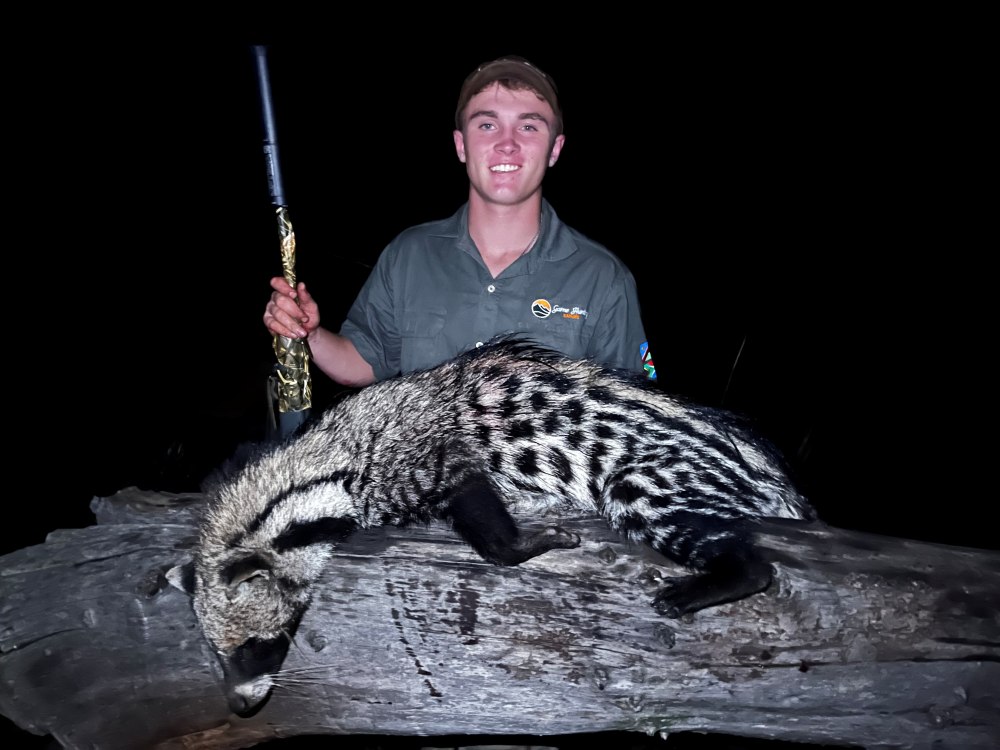This blog is written by 16-year-old game hunting enthusiast and conservationist Logan van Wyk. Logan and his family divide their time between their residence in Gauteng and their game farm in Vaalwater, Limpopo.
[DYNAMIC-BLOGTABLEOFCONTENT]
Key Takeaways
- Night hunting is an exciting addition to the usual game hunting activities, but patience and perseverance are the name of the game!
- Ensure that you are well-prepared for a night hunting adventure, from technical gadgets to staying awake, no detail is too small
- Be prepared for anything, it really is as simple as that!
- Night critters provide a whole new level of excitement for a hunting safari, where the unexpected can, and often does, happen
- Ensure that you are well-prepared in terms of firepower for any night critters that you encounter, whether it be a Civet, Honey Badger or even a Leopard!
Interesting facts about Civets
- Civets can weigh up to 15-45lbs (7-20 kgs)
- Their head and body length can range from 26.7- 30 inches
- Civets spray trees and the ground with a substance called “civet” or more specifically “civetone” which is released from their perineal glands to mark their territory. It has a yellow or white paste appearance. This scent also is quite sensitive to humans who dislike the smell, sometimes humans will use this substance to scare off other Civets if they are invading their land, home or gardens.
- You can only hunt Civets at night as they are nocturnal.
- One of the most expensive coffees worldwide is made from the droppings (stool) of the Civet, it is called Civet Coffee or also known as Kopi Laukitis coffee can cost up to $100 per kg if farmed and $1 300 per kg if they are wild collected beans.
- Find out more information about Civets.
- Interested in Civet Hunts in Africa? Prepare yourself with our Civet Hunting guide and browse our Civet Hunt Listings.
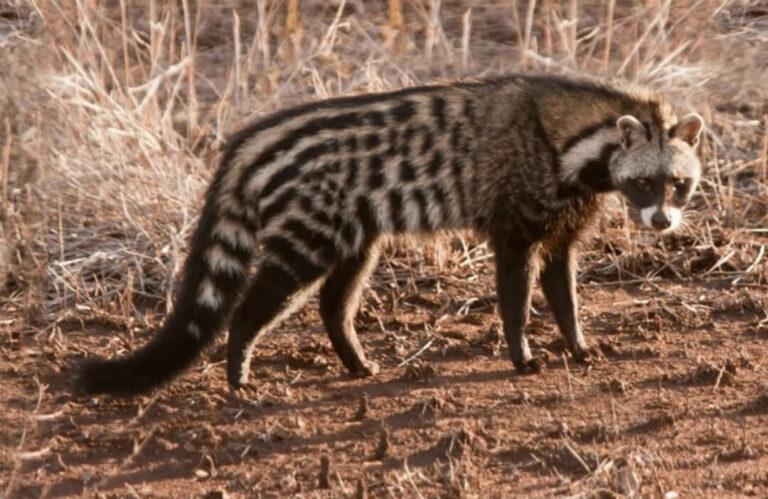
Preparing for our Hunting Adventure: Baiting
The baiting part of the hunt was where the hunting adventure began for me: It was no longer a dream but had become reality as we started the baiting process.
The baiting process is not as easy as simply just leaving any leftover food out for grabs, although I wish this were the case. Considering that our only proper opportunity for the hunt was directly in the summer and rainy season, night critters had a diverse option of meals from which to choose, and we therefore just had to make ours the most appealing and appetizing.
We (my brother Slade and I) decided to shoot three of the pigs that would be harvested for their meat to be sold, with guts to be put aside and their blood to be stored for later. The guts were kept to be thrown onto the physical bait pile that you would be shooting toward, the blood on the other hand was kept for a process called “dragging.”
The blood is kept from the animal that you harvested and is then mixed with water and all put into one bucket, then you use either the hide or guts of an animal and dip it into the mix and the drag it behind your vehicle, hence the name dragging.
The way we were dragging is simple, perhaps time consuming, but noting unmanageable. The blood is kept from the animal that you harvested and then mixed with water, and all put into one bucket, after which either the hide or guts of an animal is used and dipped into the mix. It is then dragged behind your vehicle, hence the name dragging.
You drag it for anywhere from 25-50 yards, simulating a blood trail for animals to find and follow. You repeat this process for a few miles in all directions around your bait pile, ensuring that all the trails end around your bait pile. We also decided to tie a sheep carcass around a tree and tightly securing it with wire. The sheep’s stomach was then opened and its feces spread over nearby trees. This created an irresistible stench that almost every night critter would be wanting to investigate. The wire around the carcass ensured that it didn’t come off because when you are Hyena hunting, the Hyena will generally try and drag the carcass back to their dens, meaning they may not appear for the next few nights.
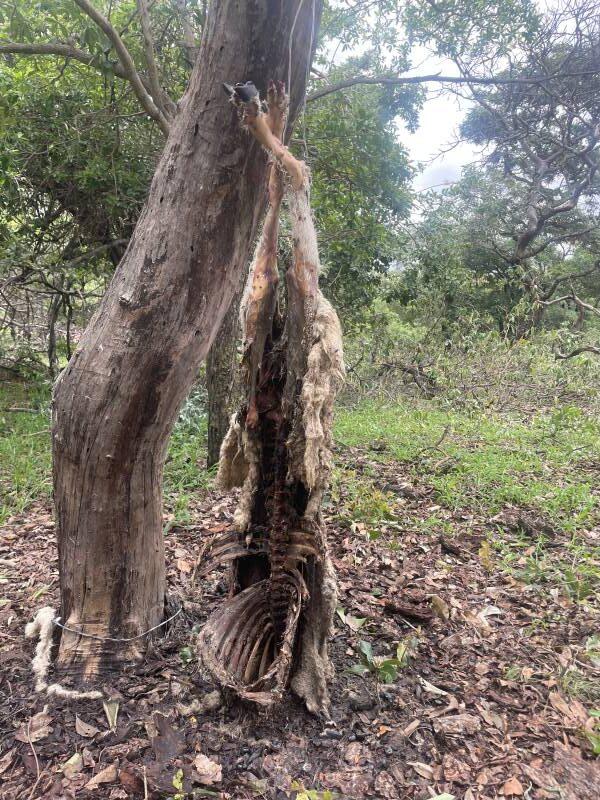
The Race is On!
After only two days after dragging and baiting, we had our first glimpse of one of our potential target animals. It was what looked to be a very nice sized Brown Hyena. Out of all the animals this was the first thing last thing we were expecting to come into the bait so suddenly!
We wasted no time during the day; we were up and about, preparing for the very long night hunt lying ahead. A few months prior my older brother, Keenan, had built a little two-man blind made from old wood and covered it shade cloth. He had built the blind to go night hunting himself and was kind enough to lend it to us. Whilst being a little too cramped and not quite dark enough, we were still extremely grateful. We set up the shooting sticks inside, squeezed in the chairs and covered the blind with some branches. We were officially prepared to start hunting!
With neither Slade nor I having night hunted out of a blind before, it was a new experience for the both of us. Luckily, we had some knowledge of how difficult it would be based off my father’s failed Hyena hunting attempts. As we sat there on our first night, I fell victim to underestimating how challenging it would be, I could not for the life of me keep my eyes open! I tried everything, talking to myself, intentionally widening my eyes and even holding the monocular to my eyes to dilate my pupils but that still wasn’t enough. I had at once stage fallen asleep, the troubles of night hunting had one that time.
Luckily for me I was not the person with the rifle: Slade and I had discussed an alternating system, one night either one of us would sit with the rifle and the monocular would be passed between the two, the night after that the person with the rifle would switch. During that night, at around 11pm, we had the same Hyena sneak up, unfortunately he crept in behind us. My not so nocturnal brain had somehow managed fall into a light sleep, luckily not snoring. The Hyena had come around 40 yards from our blind before catching wind of us and getting spooked. Even though I missed it all my brother could describe the way it was panting and even the way it was walking right behind us. Suddenly, the hunting adventure had become way more interesting!
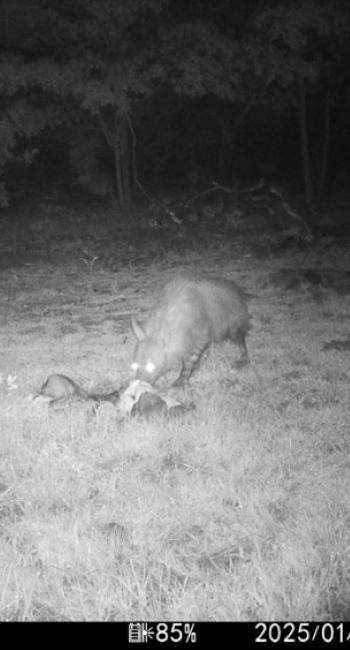
Now our hopes for Hyena hunting were even higher as we had our first signs of hope, although it would be difficult to keep the Hyena on bait considering the amount of other food options that were available. We decided that considering the direction that the wind was blowing and the fact that the Hyena knew where we were, it was best for us to switch up the location. Moving the current blind was an idea but ultimately wasn’t the best, we were worried that they notice the missing blind and would potentially make the animals wary about coming to the bait. With the help of Keenan, who had done these many times, we were able to construct a makeshift blind by cutting branches and stacking them against one another. The only downside to the location we had chosen is that the gap to potentially shoot from was a lot narrower and lower to the ground. We just said to ourselves that it would be another challenge added to our night hunting
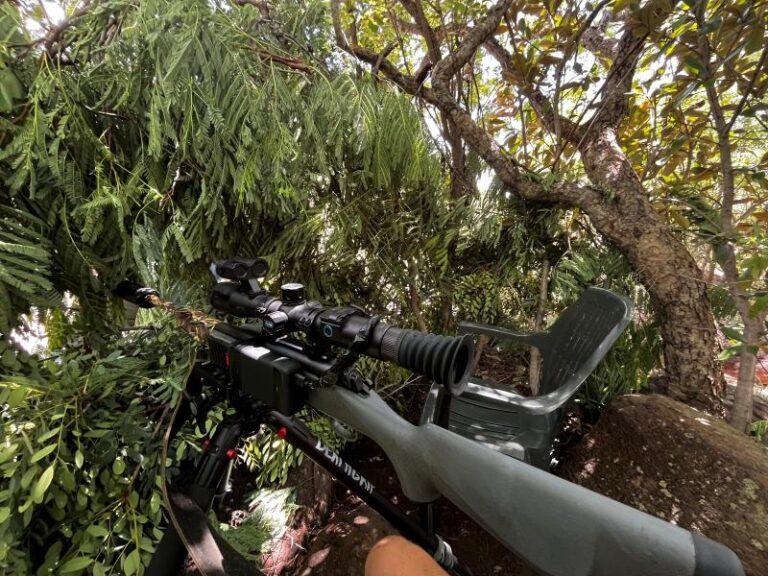
We came fully prepared for the second official night hunting night, by eating loads before the hunt and brought just shy of 2 Liters (0.5 Gallons) of coffee along with us to ensure that we stayed awake this time! This time we were not expecting anything to come close to us, which somehow backfired. Even with the wind in our favour, plenty of bait on the pile and a good sight of the bait, we just so happened to have put ourselves along the path of a Honey Badger. Out of all the things to expect on our hunting adventure, this certainly wasn’t very high on the list. While is certainly isn’t unknown that Honey Badgers can surprise you due to their curiosity and pure arrogance, what happened to us defiantly still took me by surprise.
At around 11pm we heard some movement just ahead of us. Trying to look through thermal and night vision, whatever was there was unable to be seen as it was simply too close for the equipment. We tried to stand up and glance as to what was there but were still unable to see it, all we could do was sit back and listen as it approached our blind. As the sound started shifting from in front of me to next to me and then eventually behind me, I had no idea what to do or how to approach the situation. This mysterious animal walked right behind us, driven by curiosity, and was only three to four yards at furthest. After examining whatever it thought was going on, it headed off back onto its path completely unfazed. The same cannot unfortunately be said for me: My heartrate was through the roof as I was so curious as to what animal it was and what it wanted. One or two hours later we were finally ready to head back home, with no signs of the Hyena being there again, we left our blind only to make to unsettling discovery of the Honey Badger spoor, literally a few yards from where the two of us were sitting! This was one of the weirdest moments I have ever heard of whilst Honey Badger hunting!
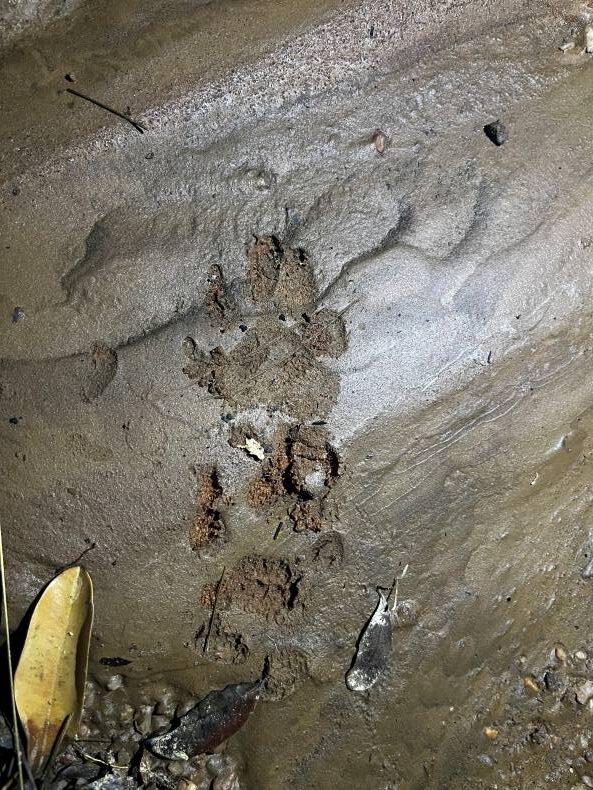
After this close encounter we faced more issues than success. While we were both anxious to have a successful night hunting adventure, the weather was rooting against us. Days upon days of rain poured upon the farm, completely rendering any chance of hunting to be less than zero. While the rain would stop during the day and our hopes were high, the weather forecast would let us down and the rain would pour throughout the night. For us hunters it wasn’t a problem, we were more than willing to sit in the rain, but it was the equipment that concerned us, as all the fancy techs would get ruined in the rain, even with covers over it. For around a week and a half it rained at night, leading to us either not going out at all or resulting in a failed night hunting trip and us returning early.
Finally, this dreaded week came to an end, the rain began to soften and not be so frequent. As fat would have it, I had become ill over the previous few days, during the only well-presented opportunity. On the first night with favorable conditions, we decided it was best to stay at home to not get any worse, but after rummaging around our medicine cabinets, we finally went back the following night.
With this being one of our final nights before school started and before the river’s water levels subsided, we needed a serious amount of luck on our side for this hunting safari! That night we arrived early at the blind, just before darkness covered the valley. The first few hours seemed to be quieter than usual, with what seemed like zero life on the farm, and our ears could only hear the little stream on the farm, merrily running in the distance. Hour after hour passed until finally Slade spotted an animal through the thermal monocular. Chills ran down my spine when Slade leaned over and whispered, “There is a Leopard at the bait…” The thought of being so close to one of these animals was indescribable, knowing how much damage they can cause! I decided to peek through the night vision scope to hopefully get some footage of the leopard but when I switched the scope on, I was staring straight at a large African Civet. My mind immedicably remembered that we had a permit on hand for one. Slade had mistaken the tail of a Civet to that of a Leopard due to its size and the awkward angle we were sitting at. I did not hesitate for a second and on the first opportunity I had, I made sure to put a good shot in. As the deafening sound of our 3006 broke the silence of the Valley, Slade told me that it was a perfect shot and he saw the Civet fall. We started packing up our belongings before rushing over to admire and appreciate the Civet, after which we made our way back to the house and fetched the vehicle.
Are you interested in finding out more about Hunting in Africa? Take a look at our guides and hunt listings below:
Click here for Civet Hunts in Africa and Civet Hunting Guide.
Click here for Spotted Hyena Hunts in Africa and our Spotted Hyena Hunting Guide.
Click here for Striped Hyena Hunts in Africa and our Striped Hyena Hunting Guide.
Click here for Brown Hyena Hunts in Africa and our Brown Hyena Hunting Guide.
Click here for Honey Badger Hunts in Africa and our Honey Badger Hunting Guide.
Frequently Asked Questions
What animal hunts Civets?
The Civet is prey to most of the predators largest than itself, this consists of different animals such as Lions, Leopards, Crocodiles, Hyena, Wild dogs and Snakes. The Civet being a smaller animal compared to others, makes it easy for predators to hunt it and therefor making it an easy prey for others.
How long do Civets live?
The African Civet can live up to 15-20 years depending on the conditions where they live and the food source provided by nature in the area, 12 years average in the wild and up to 20 years if kept in captivity.
Why is a Civet import banned?
Civet import was banned on January 13th 2004, where a study was done proving that Civets can potentially affect humans with a viral raspatory disease known as Severe Acute Raspatory syndrome.
Is a Civet an omnivore or a carnivore?
Civets are considered omnivores, this means that they will eat both plants and animal matter. They enjoy a diverse diet of fruit, small insects, small mammals and even carrion.
Where do Civets sleep during the daytime?
Civets are nocturnal animals, that sleep during the day and hunt or patrol their area at nighttime. During the day, these African cats tend to find a location with long grass and reasonably close to a water source. The grass helps by providing cover for the daytime. They also tend to stay in abandoned burros that other animals have made in the past.
A Night Hunting Adventure Beyond my Expectations!
I can with confidence say that I’ve never gone through so much work and effort to get one animal in my life! All this hard work and effort added up and was so worth it in the end, as we had learned so much and had been successful. This hunting adventure was an incredible experience and was family time well spent. And the Civet? An unexpected trophy that was harvested, and a fantastic story to tell about the nights we hunted this great African species.
